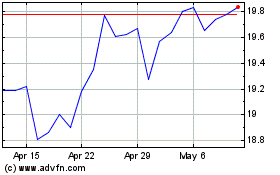U.S. Retail Sales Rose in January (and December) -- 2nd Update
13 February 2016 - 6:12AM
Dow Jones News
By Harriet Torry
U.S. consumers boosted their spending during the year's first
month, and finished 2015 on a stronger note than first thought, the
latest sign of low unemployment and cheap gasoline outweighing
concerns about market turmoil.
Sales at retail stores and restaurants rose 0.2% in January from
the prior month, the Commerce Department said Friday. December's
retail sales were revised higher, to 0.2% growth from an initially
reported 0.1% drop.
With December's revision, January marked the fourth consecutive
month of higher retail sales and showed how American households
remain relatively strong despite headwinds from global stock-market
volatility in the early weeks of 2016.
"Despite the ongoing turmoil in global financial markets,
consumer spending still managed to get off to a firm start" to the
first quarter, said Richard Moody, chief economist at Regions
Financial Corp.
Spending by consumers drives two-thirds of U.S. economic output,
and household outlays have helped the economy grow in recent
quarters despite a strong dollar and weak overseas growth, which
have burdened U.S. exporters.
Consumers continued to spend less at gas stations thanks to
lower fuel prices. But a core measure of retail sales excluding
autos and gasoline posted a 0.4% increase. Americans stepped up
spending across several major categories, including vehicles,
groceries and building materials. Compared with a year earlier,
sales grew 3.4%.
The impact of a major snowstorm in the Northeast in January was
less than feared, economists said. Sales at bars and restaurants
posted their biggest decline in two years in January, falling 0.5%
during the month. But sales at food and beverage stores rose 0.5%.
A measure of spending that includes online shopping grew 1.6%, the
most in nearly a year.
Wages rose and unemployment fell in the first month of the year,
the Labor Department said last week, providing a strong foundation
for spending growth.
While consumers appeared undeterred by the volatility in
January, a sentiment reading out Friday indicated shoppers may be
growing more nervous this month. The University of Michigan's
preliminary February sentiment index dropped to 90.7 from 92.0 in
January, which the surveyors attributed to a less favorable outlook
for the economy this year.
That could point to caution in the months ahead, economists
warned. Given financial-market uncertainty, growth in consumer
outlays will remain contingent on the job market remaining strong
and wages growing further.
"Looking at recent growth in overall consumer income there does
appear to be some buildup in spending potential--assuming recent
capital market volatility doesn't scare consumers into saving a
little more," said Steve Blitz, chief economist at ITG Investment
Research.
Companies have also warned about the impact of market jitters on
shoppers recently. Beverage giants Coca-Cola Co. and PepsiCo Inc.
both reported higher profit and raised prices in the fourth
quarter, but warned of challenges ahead due to the uncertain global
economy.
Pepsi Chief Executive Indra Nooyi cautioned the U.S. recovery
was "delicate" during an earnings call, and said she has "never
seen this combination of sustained headwinds across most economies,
combined with high volatility across global financial markets"
during her years in business.
Other indicators point to hurdles for the U.S. economy that
could crimp consumer outlays. Factory activity shrank in January
for the fourth straight month, and prices for imported goods fell
1.1%--signs that a slumping global economy, strong dollar and
plunging oil prices are weighing on U.S. inflation.
Nonetheless, Friday's reading on retail sales suggests consumers
headed into 2016 on a relatively strong footing, welcome news for a
Federal Reserve looking for evidence the U.S. economy is holding
steady amid global uncertainty.
In a speech Friday, Federal Reserve Bank of New York President
William Dudley described households as "in good shape." He said the
key sector "looks much better positioned today than in 2008 to
absorb shocks and continue to contribute to the economic
expansion."
The Federal Reserve closely watches consumer spending data as a
gauge of economic growth. Fed officials pointed to solid consumer
spending as a factor in their decision to raise interest rates in
December for the first time in nearly a decade.
Write to Harriet Torry at harriet.torry@wsj.com
(END) Dow Jones Newswires
February 12, 2016 13:57 ET (18:57 GMT)
Copyright (c) 2016 Dow Jones & Company, Inc.
Regions Financial (NYSE:RF)
Historical Stock Chart
From Mar 2024 to Apr 2024

Regions Financial (NYSE:RF)
Historical Stock Chart
From Apr 2023 to Apr 2024
